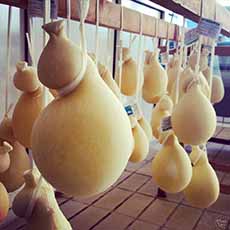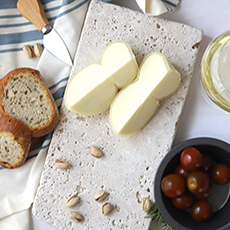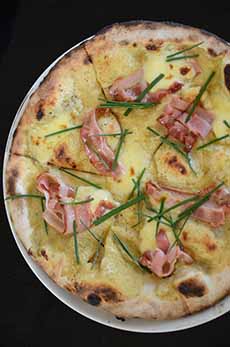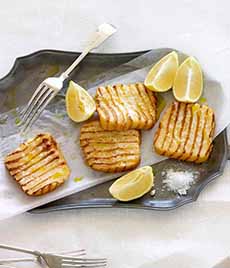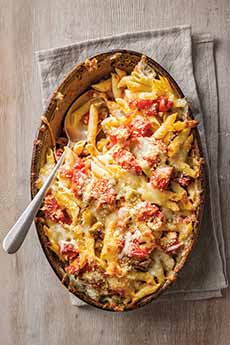Scamorza Cheese, Scamorza History, Scamorza Lasagna Recipe
|
|
October is Italian Heritage Month. Quick: Name an Italian cheese. Was it mozzarella? Now name another one. Parmigiano Reggiano? What about scamorza? Scamorza is a cousin of mozzarella, firm and shaped like a pear, with a fat body and a little head (photo #1). It’s mild in flavor with a smooth, dense texture. The paste is like mozzarella paste, only drier. First, we share how the cheese is made. Then, ways to use it, a recipe for scamorza lasagna, and the history of scamorza. Scamorza is made with fresh cow’s milk and is a semi-hard “pasta filata.” It’s a traditional food product of the regions of Campania, Abruzzo, Molise, and Puglia. The first scamorza was scamorza affumicata, cold-smoked scamorza. It’s how the Mozzarella Company makes its scamorza, which has won national awards and has been named one of the 46 best cheeses in the world. (Editor’s note: Start with the best. Buy it here.) Unsmoked scamorza is also made. In Italy it’s called scamorza bianca, white scamorza. After two weeks of ripening, it’s sold unsmoked; or else smoked for for 15 minutes over flaming straw [source]. The traditional way: Scamorza is also made in a novelty pig shape, scamorza maialino (pig), which may delight children, but doesn’t provide a lot of cheese. Some purchase it to bring good luck for the new year. Buy a great one: Order it from MozzCo. And treat yourself to any and all of the other wonderful cheeses, as well. This recipe is from Paula Lambert, founder of the Mozzarella Company. You’ll need béchamel sauce for this recipe. You can make it with this recipe (just omit the Dijon). Paula suggests pairing the lasagna with an oak-aged Chardonnay. Ingredients 1. PLACE the dried mushrooms in a small bowl and rinse with warm water. Drain and cover the mushrooms with 1 cup of very hot water. Let stand in the water for 30 minutes to one hour. In the meantime, sauté the fresh mushrooms over high heat in the butter in a medium skillet, until barely limp, about 3 to 4 minutes. Sprinkle lightly with salt and herbs de Provence. Set aside. 2. BRING a large stockpot full of water to a boil. Add the salt, olive oil, and the lasagna noodles. Cook uncovered over high heat until they are al dente. Drain the pasta in a colander and then quickly rinse with cold water to cool the pasta (and stop them from cooking further). 3. SPREAD the pasta on sheets of plastic wrap that have been placed on top of a dish towel to absorb the dripping water. If you stack it, place plastic wrap between the layers of pasta. 4. POUR the rehydrated porcini mushrooms into a sieve, saving their liquid in a bowl beneath. Chop the mushrooms and add to the skillet with the fresh mushrooms. Set them aside. 5. STRAIN the mushroom water through a sieve, or several thicknesses of cheesecloth, into a small saucepan. Place over medium heat and boil the mushroom water to reduce to half its volume. Then add it to the mushrooms. 6. PREHEAT the oven to 350°F. Butter an 8″ x 13″ x 2-1/2″ baking dish. Rub the bottom and sides of the baking dish with 1 tablespoon butter. Ladle a couple of spoonfuls of béchamel sauce on the bottom of the dish, and spread it out with the spoon. Place a solid layer of lasagna sheets first, then spread with béchamel sauce and sprinkle with the mushrooms and scamorza. 7. REPEAT the layering process three more times until all the ingredients and pan juices are used, ending up with béchamel sauce covered with scamorza on top. Bake the lasagna uncovered for 45 minutes to 1 hour, until the lasagna is bubbly and nicely browned on top. 8. REMOVE from the oven and allow to stand at room temperature for 10 minutes before cutting into squares approximately 3″x3″. Scamorza originated in southern Italy, and is still produced in Abruzzo, Campania, Molise, and Puglia. It is the oldest recorded dairy product of Campania, since around 1600. It is believed that the term scamorza derives from the verb scamozzare, which means to eliminate a part. What part is eliminated? It happens when the cheesemaker breaks the upper part of the dough to create the signature bottleneck shape of the curious cheese. According to tradition, scamorza was an accident: a mistake during the production of provolone or caciocavallo*, which inadvertently went sour. Until a few decades ago, cheesemaking was done at home, with the smoking done in the chimney of the kitchen. Each family had its own cow to provide milk [source]. Scamorza was traditionally smoked over beechwood, which adds a delicate, sweet note to its milky flavor. Today it is available both smoked and unsmoked. Although cow’s milk is the original, variations with water buffalo’s milk or sheep’s milk also are made. *Caciocavallo means “cheese on horseback.” This description derives from the manner in which the cheese is always tied together in a rope and hangs from a beam or a wooden board to drain and age. Like scamorza, mozzarella and others, it is a pasta filata: a stretched cheese that is typical of Southern Italy. It is produced with the same ingredients: cow’s milk, rennet, milk enzymes and salt. It is hand-shaped, reminiscent of the number 8: two rounded bodies joined by a bottleneck, which happens at the point of support on the beam. †Herbes de Provence is a mixture of dried herbs popular in the Provençal cuisine (southeastern France). Formerly simply a descriptive term (in the manner of “Italian herbs”), wherein cooks chose their favorite herbs to season their dishes (typically grilled foods and stews), commercial blends began to be sold as herbes de Provence in the 1970s. These blends can contain any variety of marjoram, oregano, rosemary, savory and thyme. Lavender leaves are often included in products sold in the North American market [source]. |
|
|
|
||
